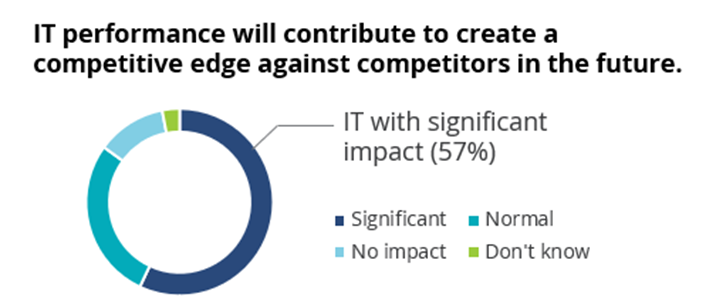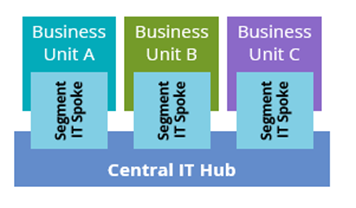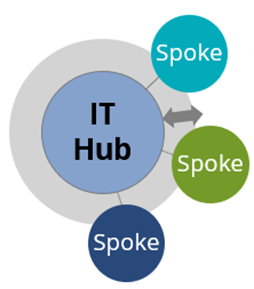IT Needs a New Mode of Operation
What will be the role of IT for the organization in the future?
This question has been a constant concern of IT leaders and is more relevant than ever. Cloud transformation, big data, artificial intelligence, machine learning, cybersecurity – the IT universe is in constant flux. According to ISG Research, most companies believe their IT organizations’ performance is critical to the business’s ability to differentiate from competitors.

Figure 1: The significance of IT performance to competitiveness
This result shows the increasing importance of strong IT capabilities in the era of digital transformation. When we imagine the future role of IT in an organization, we need to think about how to organize the IT department and how to facilitate its interaction with the business units.
There are various traditional ways to organize IT.

Figure 2: Three typical ways to organize the IT function
- Decentralized: IT is fully integrated into the business units with no central IT unit providing standardized IT services. Decentralized IT enables full flexibility for each business unit to adapt IT to its individual requirements to foster innovation.
- Hybrid: IT is partly centralized in a central IT unit (providing standardized IT services across business units) and partly integrated into the business units.
- Centralized: IT is fully centralized in one IT unit, which manages and provides highly standardized IT services for all business units. Centralized IT provides significant synergy potential through a high degree of standardization focusing on efficiency.

Figure 3: Schematic view for typical ways of organizing IT
Each of the above models has advantages and disadvantages. Deciding which is best for a particular organization can be difficult because different challenges facing IT organizations require different approaches. Table 1 shows some common challenges and typical ways of organizing IT to solve them.
Table 1: Common IT challenges and typical ways of organizing the IT function to address them
IT Challenges | Typical ways of organizing the IT Function |
Need for innovation | Decentralized/hybrid |
Transfer of IT responsibilities to business units | Decentralized |
Technical debt | Decentralized |
Shadow IT | Decentralized/hybrid |
No or low standardization | Centralized |
Cost pressure | Centralized |
Duplicate services | Centralized |
Source: ISG
In the past, enterprises have periodically switched between centralized and decentralized IT to increase efficiency and standardization by realizing synergies or foster innovation by providing flexibility to the business units. In time, it became clear that a fully centralized or decentralized IT was not suitable to solve all major challenges IT organizations are currently facing. Therefore, the hybrid model is becoming increasingly present in the market because it combines the positives of centralization and decentralization by orchestrating IT to enable innovation through flexibility without sacrificing synergies through standardization.
The Golden Middle: Leveraging Synergies and Enabling Business-Specific Solutions
Like a pendulum, contemporary businesses should strive to find the "golden middle" to fully utilize their capabilities. Otherwise, they will have to manage the drawbacks of a fully decentralized, centralized or poorly managed hybrid IT unit. Some of the drawbacks of each traditional organization model are described below.
Decentralized IT Function
- Due to a lack of collaboration between business units, departments often work unknowingly with the same software solutions that have been bought (or self-developed) and configured by another team in the same organization. New IT solutions are routinely introduced to the market, and employees don’t always possess the specialized IT knowledge they need. They are unaware of the benefits and drawbacks of a solution, how to use it and any challenges it may provide.
- Maintaining robust cybersecurity is harder and costlier in a heterogenous IT environment than in centralized models.
- If each business unit has its own data lake, lots of potential is missed. A decentralized IT function cannot fully utilize and monetize the data gathered and created across an entire organization.
- When each problem is solved separately in separate business units, the organization cannot reap the rewards of cooperation effects and synergies.
- Independent software acquisitions by each department reduce the purchasing power and increase the total cost of ownership for the organization as a whole.
- When sourcing transactions happen in different business units, they do not get the full legal review they need to adequately manage risk.
- Due to the increasing speed of technological innovation, it is difficult for each IT unit to keep up with the latest capabilities, skills, technologies and solutions, thus it is more time consuming and drastically increases the costs.
- Decentralized IT also complicates business unit integration and makes it more difficult to exchange information between them.
Centralized IT Function
- A centralized IT unit lacks in-depth knowledge of the specific processes and difficulties abusiness unit faces and is often, therefore, unable to provide the ideal answer and solution. Inappropriate solutions can cause employee morale to suffer because daily duties can become more challenging or lead to customer dissatisfaction.
- Being centralized means IT must expend greater effort for collaboration within a management layer (IT business partners) to "translate" and manage the business needs across an additional chain in the communication.
- Centralized IT also must prioritize across multiple business units that have competing needs, which can slow responses and potentially influence shadow IT development as BUs seek to resolve their needs through other channels.
- The complexity of a solution increases if the solution must fulfil different needs for a variety of stakeholders. These features may then not be relevant for all stakeholders.
Hybrid IT Function
- A hybrid model in which IT is partly centralized and partly integrated into business units often causes duplicate effort due to unclear responsibilities and roles.
- A hybrid model can also cause tension between business units when it is not clear which business unit has authority over a topic. To avoid long political discussions, often a business unit will decide to develop or buy its own software, which leads to shadow IT.
- The process of decision-making is more complex, since it is not clear what is in the centralized portion versus the decentralized portion.
Introducing the Hub-and-Spoke IT Operating Model
To maximize the benefits of the traditional IT operating model, a combination of centralized and decentralized IT functions is necessary. This is what we refer to as the Hub-and-Spoke IT Operating Model. The goal of the Hub-and-Spoke IT Operating Model is to increase innovation and continuous improvement in an organization without slowing down the operative business or disproportionally increasing the costs.
To achieve a balance between flexibility and standardization that supports digital innovation without compromising cooperation, enterprise IT is coordinated centrally (with a central IT hub) but performed decentrally in the business units (segment IT spoke). This means some capabilities will be operated and delivered centrally (the hub), while others will be distributed (the spokes).
Figure 4: Orchestrated Hub-and-Spoke IT Operating Model
The Hub-and-Spoke IT Operating Model adheres to the following principles:
- The business units are responsible for how to use these services and how to implement them.
- The central IT hub offers standard enterprise-wide services for products, processes and office IT and orchestrates digital capability adoption to facilitate a data-driven enterprise.
- The decentralized segment IT spokes implement digital innovation and IT solutions that are specific to business units.
- A centralized team or function focuses on the incubation and adoption of new technologies, processes and products. Through the exchange of knowledge and best practices, centers of excellence (CoE) and communities of practice (CoPs) connect various spokes to create synergies.
When new technologies or services are being implemented and operationalized at the enterprise level, specialized skills and expertise are necessary. Ultimately, a CoE should commoditize these skills in the organization, so that related responsibilities can be given to product teams or spokes and the CoE can be dissolved.
The Goal of a Center of Excellence
A CoE is a centralized team or function that concentrates on the incubation and adoption of solutions by offering leadership/orchestration, standards, best practices, research, training, measurements, skills and expertise. A CoE's main goal is to directly empower capabilities in the business unit IT teams or in the hub. CoEs are especially helpful for subjects that need centralized orchestration, for locations with limited resources and for expediting the adoption of innovative technology. Multiple CoEs (e.g. cloud, agile, automation, etc.) can serve as hubs for knowledge management, ongoing best practice improvement and encouraging reusability of spoke solutions. The duties are carried out through conventional governance, CoP facilitation, team coaching participation and member rotation.
The Goal of a Community of Practice
A CoP is a cooperative group of practitioners that is frequently open to anybody who is interested in joining. CoPs are jointly responsible for concentrating on locating, disseminating and putting into action best practices in their own service or feature teams. It is important that clear mandates and responsibilities are set to open the full potential of a Hub-and-Spoke IT Operating Model.
How Clear Mandates and Responsibilities Unlock Value

Figure 5: Responsibility split between the IT hub and the spokes
Clear mandates and responsibilities need to be jointly defined between the IT hub and the spokes, as well as publicly and openly communicated and lived as such. While there are some typical responsibilities owned by either the central IT hub or decentralized business units, there are many decisions that must be made to determine the best possible setup for a particular company. Most importantly, the IT hub delivers standardization and supports innovation in a way that is suitable to the IT organization. The setup of these different areas of responsibility is highly specific to a company’s strategy, especially regarding its ways of working, governance and culture.
An exemplary distribution of the responsibilities is shown in the table below:
IT Hub
Enterprise-wide IT strategy is coordinated by a central IT organization led by the CIO.
Responsibilities:
- Supplying IT spokes with standard platform solutions to develop solutions on IaaS, PaaS or SaaS
- Finding and providing specialized knowledge and resources that decentralized units cannot fully provide
- Offering and developing innovative workplace services
- Providing IT innovation, standards, procedures and policies
- Controlling/benchmarking IT
- Managing strategic partnerships
Gray Area
Work that might be managed by the central hub or the decentralized spokes
Responsibilities:
- Delivering solutions and change management
- Operating and maintaining developed applications
- Developing innovations in
non-core business models - Administering licenses
Spokes (Business Unit)
For each distinct business unit or corporate function, a decentralized IT spoke implements solutions in feature and business services teams.
Responsibilities:
- Implementing the digital strategy for the relevant business unit or corporate function by creating innovative products, manufacturing processes and business services
- Contributing to the broader enterprise IT strategy in a way that is relevant to IT
- Overseeing the effective acceptance and deployment of created solutions and commercial services (incl. P&L responsibility)
- Monitoring the performance and value contribution of each feature or service team
Benefits of Clear Mandates and Responsibilities
We have seen many companies without clear mandates and responsibilities. They run into problems such as multiple divisions or teams developing similar solutions in parallel, unnecessarily complicated processes and creating redundancies. Clearly defining mandates and responsibilities has many advantages and is especially important for a hybrid, interconnected model such as the Hub-and-Spoke Model.
The most important advantages of clearly defining the mandates and responsibilities are:
- Avoiding waste / double work by ensuring alignment across the organization
- Avoiding shadow IT
- Enabling specialization for the spokes
- Leveraging centralized advantages of standardization for the hub
Achieving Clear Mandates and Responsibilities
But how do we achieve these clear mandates and responsibilities?
We do so by setting up a central governing coalition that determines the responsibilities between the hub and spokes and ensures that the right degree of standardization and specialization is chosen for the individual solutions. This will enable digital innovation without sacrificing synergies.
To set it up for success, it should be staffed with representatives from both the IT hub as well as the IT spokes to create a collaborative environment. While the governing coalition is an essential part of the Hub-and-Spoke IT Operating Model, it should still be set up to be as lean as possible. The governing coalition creates the environment to discuss any topics with unclear responsibilities (such as the gray area mentioned above) and align the mandates and responsibilities to resolve them.
Employees are encouraged and enabled to work with an agile mindset and culture, in teams with end-to-end responsibility. As much responsibility as possible is pushed down to the business unit or the central IT hub to cut down on unclear responsibilities that need to be resolved with long governance meetings as part of a governing coalition. This keeps alignment needs to a minimum to maximize time spent working on the solutions. To achieve this, the value proposition of each service needs to be clearly defined and aligned to the business. Common examples where alignment is needed include IT strategy and architecture guidelines and practices for identity, access and cybersecurity.
Both the IT hub and the spokes need a “local” design authority that translates the decisions from the governing coalition into concrete actions for the respective hub / spokes as well as ensuring compliance to the jointly defined policies and standards within their respective organization.
Summary: Benefits of Hub and Spoke
To put it in a nutshell, the Hub-and-Spoke IT Operating Model has the following advantages:
- It creates an environment that fosters fluid IT in delivering the right services and solutions to the business by having the IT delivery close to the business for those capabilities that differ from one business unit to another.
- It enables faster IT by better alignment and streamlined decision-making through the governing coalition, as well as through clear mandates and responsibilities.
- It encourages reusability of spoke solutions / fostering and spreading innovation through the effective usage of CoE and CoPs.
- It fosters innovation relevant for the business with new digital products and services. New IT leverages digital technologies and best practices.
- It optimizes IT costs by reducing organizational complexity and redundancies while leveraging synergies through economies of scale with simplified IT services.
ISG has a vast experience in designing and implementing hub-and-spoke operating models in IT organizations from various industries. Through our proven frameworks, tools and methods, we are able to accelerate the creation and implementation of a future-oriented hub-and-spoke operating model in your IT organization. If you want to find out more, don’t hesitate to contact us!
